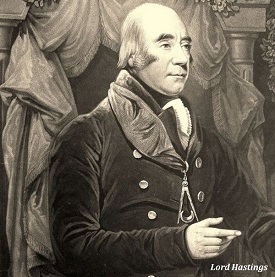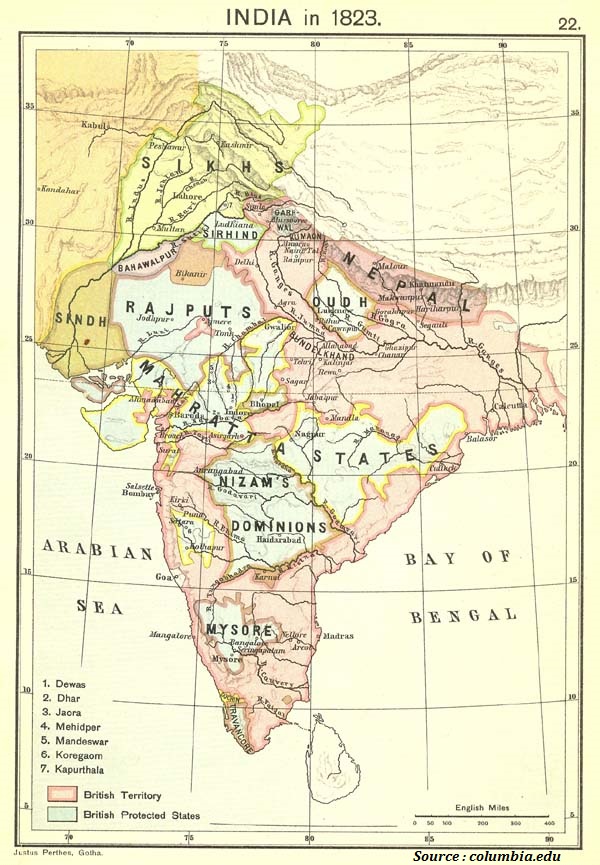
- Modern Indian History Tutorial
- Modern Indian History - Home
- Decline of Mughal Empire
- Bahadur Shah I
- Jahandar Shah
- Farrukh Siyar
- Muhammad Shah
- Nadir Shah’s Outbreak
- Ahmed Shah Abdali
- Causes of Decline of Mughal Empire
- South Indian States in 18th Century
- North Indian States in 18th Century
- Maratha Power
- Economic Conditions in 18th Century
- Social Conditions in 18th Century
- Status of Women
- Arts and Paintings
- Social Life
- The Beginnings of European Trade
- The Portuguese
- The Dutch
- The English
- East India Company (1600-1744)
- Internal Organization of Company
- Anglo-French Struggle in South India
- The British Conquest of India
- Mysore Conquest
- Lord Wellesley (1798-1805)
- Lord Hastings
- Consolidation of British Power
- Lord Dalhousie (1848-1856)
- British Administrative Policy
- British Economic Policies
- Transport and Communication
- Land Revenue Policy
- Administrative Structure
- Judicial Organization
- Social and cultural Policy
- Social and Cultural Awakening
- The Revolt of 1857
- Major Causes of 1857 Revolt
- Diffusion of 1857 Revolt
- Centers of 1857 Revolt
- Outcome of 1857 Revolt
- Criticism of 1857 Revolt
- Administrative Changes After 1858
- Provincial Administration
- Local Bodies
- Change in Army
- Public Service
- Relations with Princely States
- Administrative Policies
- Extreme Backward Social Services
- India & Her Neighbors
- Relation with Nepal
- Relation with Burma
- Relation with Afghanistan
- Relation with Tibet
- Relation with Sikkim
- Relation with Bhutan
- Economic Impact of British Rule
- Nationalist Movement (1858-1905)
- Predecessors of INC
- Indian National Congress
- INC & Reforms
- Religious & Social Reforms
- Religious Reformers
- Women’s Emancipation
- Struggle Against Caste
- Nationalist Movement (1905-1918)
- Partition of Bengal
- Indian National Congress (1905-1914)
- Muslim & Growth Communalism
- Home Rule Leagues
- Struggle for Swaraj
- Gandhi Assumes Leadership
- Jallianwalla Bagh Massacre
- Khilafat & Non-Cooperation
- Second Non-Cooperation Movement
- Civil Disobedience Movement II
- Government of India Act (1935)
- Growth of Socialist Ideas
- National Movement World War II
- Post-War Struggle
- Clement Attlee’s Declaration
- Reference & Disclaimer
Modern Indian History - Lord Hastings
Marquess of Hastings (Lord Hastings) was appointed Governor-General of India on November 11, 1812. His tenure in India as Governor-General was a notable one, as he won two wars namely the Gurkha War (1814–1816) and the Maratha War (1818).

The Second Anglo-Maratha War had shattered the power of the Maratha chiefs but not their spirit. The loss of their freedom rankled in their hearts. They made a desperate last attempt to regain their independence and old prestige in 1817.
The lead in organizing a united front of the Maratha chiefs was taken by the Peshwa who was smarting under the rigid control exercised by the British Resident. However, once again the Marathas failed to evolve a conceded and well-thought out plan of action.
The Peshwa attacked the British Residency at Poona in November 1817. Madhoji II Bhonsle (also known as Appa Sahib) of Nagpur attacked the Residency at Nagpur, and Madhav Rao Holkar made preparations for war.
The Governor-General, Lord Hastings, struck back with characteristic vigor.
Hastings compelled Sindhia to accept British suzerainty, and defeated the armies of the Peshwa, Bhonsle, and Holkar.
The Peshwa was dethroned and pensioned off at Bithur near Kanpur. His territories were annexed and the enlarged Presidency of Bombay brought into existence.
Holkar and Bhonsle accepted subsidiary forces. All the Maratha chiefs had to cede to the Company large tracts of their territories.
To satisfy Maratha pride, the small Kingdom of Satara was founded out of the Peshwa's lands and gave to the descendant of Chhatrapati Shivaji who ruled it as a complete dependent of the British.
Like other rulers of Indian states, the Maratha chiefs too existed from now on at the mercy of the British power.
The Rajputana states had been dominated for several decades by Sindhia and Holkar. After the downfall of the Marathas, they lacked the energy to reassert their independence and readily accepted British supremacy.
By 1818, the entire Indian sub-continent excepting the Punjab and Sindh had been brought under British control.

Some part of India was ruled directly by the British and the rest by a host of Indian rulers over whom the British exercised paramount power (as shown in the map given above).
The British protected states had virtually no armed forces of their own, nor did they have any independent foreign relations. However, they were autonomous in their internal affairs, but even in this respect, they acknowledged British authority wielded through a Resident.
The British protected states paid heavily for the British forces stationed in their territories to control them.